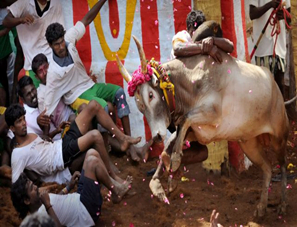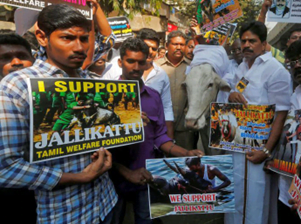Governance
Context: Recently, the Tamil Nadu government has defended Jallikattu in the Supreme Court stating that the Jallikattu has both religious and cultural significance for the people of Tamil Nadu and its influence is beyond the confines of caste and creed. The State protested that the ban on Jallikattu was perceived as an onslaught against the cultural identity of the people of Tamil Nadu.


About Jallikattu:
- Jallikattu is a bull taming competitive sport and a tradition over 2,000 years old in part of Tamil Nādu.
- The word ‘Jallikattu’ has evolved from the words ‘Calli’ (coins) and ‘Kattu’ (tie), which denote a bundle of coins tied to the bull’s horns.
- There are references of Jallikattu in Silappatikaram, the great epics of Tamil classical period.
- It is celebrated in the second week of January, during the Tamil harvest festival, Pongal.
- It is popular in Madurai, Tiruchirappalli, Theni, Pudukkottai and Dindigul districts of Tamil Nadu known as the Jallikattu belt.
- The most popular Jallikattu is the one celebrated at Alanganallur near Madurai.
History of the event:
- Jallikattu has been known to be practiced during the Tamil classical period (400-100 BC).
- It was common among the Ayyar people who lived in the ‘Mullai’ geographical division of the ancient Tamil country.
- Later, it became a platform for display of bravery and prize money was introduced for participation encouragemen
- A seal from the Indus Valley Civilization depicting the practice is preserved in the National Museum, New Delhi.
- A cave painting in white kaolin discovered near Madurai depicting a lone man trying to control a bull is estimated to be about 1,500 years old.
Timeline of Legal issues of Jallikattu:
- Jallikattu first came under legal scrutiny in early 2000s when the Animal Welfare Board of India and the animal rights group People for the Ethical Treatment of Animals (PETA) moved petitions in the Supreme Court against Jallikattu as well as bullock cart races.
- In 2011, the Environment Ministry at the Centre issued a notification specifically mentioning ‘bulls’.
- The Jallikattu practice continued to be held because of the Tamil Nadu Regulation Act No. 27 of 2009 even after the 2011 notice.
- The Animal Welfare Board of India (AWBI) and PETA filed a petition in the Supreme Court again and contested that –
- The regulations were not being followed and that bulls were indeed being subjected to cruelty as defined under the Prevention of Cruelty to Animals Act, 1960.
- The Supreme Court in its 2014 verdict banned Jallikattu and struck down the Tamil Nadu Regulation of Jallikattu Act, 2009.
- In January 2016, in what could be seen as a clearly political move, the union environment ministry revoked the ban by issuing a notification months before the elections in Tamil Nadu were due to be held.
- The Supreme Court stayed this 2016 Union Government notification, as it was challenged by the AWBI and PETA.
- In January 2017, several hundreds of protesters conducted a rally at Chennai Marina opposing the ban on Jallikattu.
- Tamil Nadu passed the Prevention of Cruelty to Animals (Tamil Nadu Amendment) Act of 2017 and Prevention of Cruelty to Animals (Conduct of Jallikattu) Rules of 2017.
- The statutes had re-opened the gates for the conduct of the popular bull-taming sport in the name of culture and tradition despite the 2014 ban by the Supreme Court.
- In the aftermath of Jallikattu comeback due to Tamil Nādu legislation the Supreme Court had referred a bunch of petitions to the Constitution Bench in February 2018.
Arguments against the Jallikattu:
- Ethical issues: An investigation by the Animal Welfare Board of India concluded that “Jallikattu is inherently cruel to animals”.
- Human deaths: The event has caused several human deaths and injuries and there are several instances of fatalities to the bulls.
- Cruelty to animal: A report submitted by the AWBI before the Supreme Court in this case highlighted unimaginable torture inflicted- tails twisted and fractured, chemicals poured into eyes, ears mutilated, sharp edged weapons used to poke the animal.
- Manhandling of animals: Animal welfare concerns are related to the handling of the bulls before they are released and also during the competitor’s attempts to subdue the bull.
Arguments in favour of Jallikattu:
- Cultural Representation: There exists tangible evidence to show that this battle between man and beast is a cultural representation.
- Agrarian Economy: The political economy of such games is about showcasing the quality of cattle, the breeding skills of cattle rearers, the centrality of cattle in an agrarian economy, and the power and pride they bring to farmers.
- Agrarian Culture: Such games are a cultural manifestation of this political economy. As a tradition, it links an agrarian people to the elemental aspect of their vocation.
- Symbol of Tamil Culture: Jallikattu’s linkages with Pongal has lifted it above its regional and community origins and transformed it into a symbol of Tamil culture and pride.
- Shapes Political Discourse: Pride in Tamil culture is central to Dravidian nationalism, which continues to shape the political discourse in Tamil Nadu.
Way Forward:
Although there are systems in place to check treatment of the bulls and ensure safety of participants and spectators, animal cruelty still continues and people continue to lose their lives. There needs to be a comprehensive regulatory framework in place with zero implementation gaps to check treatment of animals and ensure safety of participants and spectators.
Source: The Hindu
Additional Information:
About Animal Welfare Board of India (AWBI)
- It is a statutory body established in 1962 under Section 4 of the Prevention of Cruelty to Animals Act, 1960.
- It is headquartered at Ballabgarh in Faridabad District of Haryana.
- The Board was initially within the jurisdiction of the Government of India’s Ministry of Food and Agriculture.
- In 1990, the subject of Prevention of Cruelty to Animals was transferred to the Ministry of Environment and Forests, where it now resides.
Composition:
- The Board consists of 28 Members, who serve for a period of 3 years.
Functions:
- It is an advisory body advising the Government of India on animal welfare laws, and promotes animal welfare in the country of India.
- It works to ensure that animal welfare laws in the country are followed and provides grants to Animal Welfare Organizations.
- It frames a range of rules on how animals ought to be humanely treated everywhere.
- It has also frequently litigated to have stricter laws to ensure animals were not unduly harassed or tortured.













